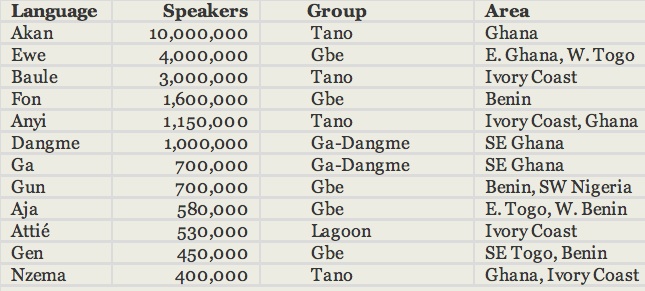An insatiable appetite for ancient and modern tongues


Name Origin: Kwa means 'man' or 'person' in several Kwa languages.
Overview and Distribution. The Kwa family (or branch) is part of the Niger-Congo phylum. It consists of some 50 languages spoken by about 25 million people in the west coast of Africa from Ivory Coast to western Nigeria, particularly in southeastern Ivory Coast, south Ghana, south Togo and south Benin. The largest Kwa languages are: Baule, Akan and Ewe.
External Classification: Niger-Congo, Atlantic-Congo, Volta-Congo. Kwa is one of the nine families (or branches) of the Niger-Congo phylum.
Internal Classification. The size and composition of the Kwa family has varied with different evolving classifications. At some point, it included Liberian and Nigerian languages which are excluded in the most recent by Williamson and Blench (2000). Kwa has more than 50 members divided into several, partly geographical and partly genetical, groups, which are from west to east:
-
a) Lagoon languages, of Ivory Coast (7):
-
•Avikam
-
•Alladian
-
•Adjukru
-
•Abidji
-
•Abbey (Abé)
-
•Attié
-
•Ega.
-
b) Potou-Tano, of Ivory Coast and Ghana (20):
-
Potou
-
•Ebrie (Ebrié) and Mbatto (Mbato).
-
Tano
-
•Krobu, Abure and Eotilé (Beti), spoken in Ivory Coast
-
•Nzema, Ahanta, Anyi (Anyin) and Baule (Baoule), spoken in eastern Ivory Coast and western Ghana
-
•Anufo spoken in northeastern Ghana
-
•Akan with by far the most speakers, mainly in Ghana
-
•the Guang subgroup: Gonja, Nawuri, Nchumuru (Nchumbulu), Krachi (Krache), Nkonya, Okere (Cherepon), Larteh, Efutu, and Awutu, spoken in Ghana along the course of the Volta river.
-
c) Ga-Dangme, in southeastern Ghana (2):
-
-
•Ga
-
•Dangme (Adangme).
-
d) Central Togo or Togo Mountain languages (14):
-
-
NA subgroup
-
•Basila (Anii)
-
•Lelemi (Lefana)
-
•Logba, Adele
-
•Likpe (Sekpele)
-
•Santrokofi (Sele)
-
•Akpafu-Lolobi (Siwu).
-
KA subgroup
-
•Avatime
-
•Nyangbo-Tafi
-
•Bowiri (Tuwili)
-
•Ahlo, Kposo (Akposo)
-
•Kebu (Akebou)
-
•Animere.
-
e) Gbe, in eastern Ghana (beyond the Volta River), Togo, Benin and western Nigeria (6):
-
-
•Ewe
-
•Gen
-
•Aja
-
•Maxi
-
•Fon
-
•Gun.
Speakers. Kwa languages are spoken by approximately 25 million people. The largest are:

SHARED FEATURES
-
✦ Phonology
-
-Vowel harmony: In many Kwa languages, particularly in the Tano subgroup, there is a contrast between vowels pronounced with an advanced tongue root (+ATR) and a retracted tongue root (–ATR): only vowels from (+ATR) set or from (–ATR) set appear in the same word.
-
-There is a contrast between strongly and weakly articulated sounds. Labio-velar consonants (mostly voiceless kp, less frequently voiced gb) occur in Ga-Dangme, Central Togo languages and in Gbe.
-
-Tones: Kwa languages have two to five tones which serve to make lexical and grammatical distinctions.
-
✦ Morphology
-
-Nominal morphology is variable. Some Kwa languages have several noun classes marked by specific singular and plural prefixes; noun modifiers and pronouns might show agreement with the noun by having the same noun class prefix. In contrast, Tano languages do not usually show agreement though they use singular and plural prefixes. In Ga-Dangme the singular is unmarked and the plural is marked with just one suffix. Gbe languages use a particle at the end of the phrase to mark the plural.
-
-In the verbal system, aspect is more important than tense. The main contrast is between imperfective, perfective and progressive aspects, and secondarily between future and non-future tenses.
-
-Serial verb constructions are frequent in all Kwa languages. In them, several verbs having the same subject and sometimes object, stand together without a conjunction.
-
✦ Syntax
-
-In all Kwa languages, the basic word order is Subject-Verb-Object. They are head-initial, noun modifiers (adjectives, articles, etc) following the noun. The possessor precedes the possessed.
-
© 2013 Alejandro Gutman and Beatriz Avanzati
Further Reading
-
-'Niger-Congo'. K. Williamson & R. Blench. In African languages: An Introduction, 11-42. B. Heine & D. Nurse (eds). Cambridge University Press (2000).
-
-The Languages of Ghana. M. E. K. Dakubu (ed). Kegan Paul International (1988).
-
-'Kwa'. J. M. Stewart. In The Niger-Congo languages, 217-245. J. Bendor-Samuel (ed). University Press of America (1989).
-
-'Kwa Languages'. M. E. K. Dakubu. In Concise Encyclopedia of Languages of the World, 630-633. K. Brown & S. Ogilvie (eds). Elsevier (2006).
-
-'Les Langues Kwa'. G. Herault. In Les Langues dans le Monde Ancien et Moderne, 1139-1146. J. Perrot (ed). Centre National de la Recherche Scientifique (1981).
Kwa Languages

Address comments and questions to: gutman37@yahoo.com
MAIN LANGUAGE FAMILIES
LANGUAGE AREAS
Languages of Ethiopia & Eritrea
LANGUAGES by COUNTRY
LANGUAGE MAPS
-
• America
-
• Asia
-
Countries & Regions
-
-
Families
-
• Europe
-
• Oceania